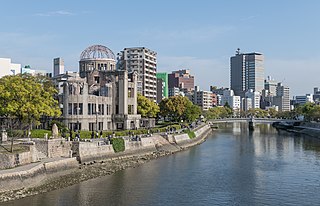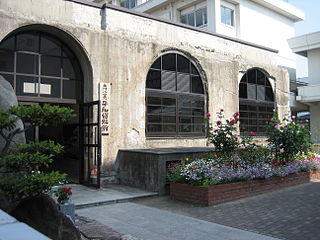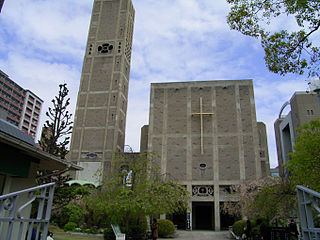
Hiroshima National Peace Memorial Hall for the Atomic Bomb Victims is one of the National Memorial Halls in Hiroshima, Japan.

Hiroshima National Peace Memorial Hall for the Atomic Bomb Victims is one of the National Memorial Halls in Hiroshima, Japan.
The Hall was founded by the Japanese national government to mourn the atomic bomb victims in 2002. It was designed by Kenzō Tange. There is another National Peace Memorial Hall for the Atomic Bomb Victims in Nagasaki built for the same purpose.
The Hall is in Hiroshima Peace Memorial Park near Hiroshima Peace Memorial across the "Motoyasu River" by "Motoyasu Bridge". The Hall curators are collecting atomic bomb memories and stories from the survivors to mourn the victims, as the survivors are aging. They are also collecting names and photographs of atomic bomb victims for the same purpose and for the same reason. From the collection, they are developing a project to "read the stories of the atomic bombing".
Admission is free of charge.

Hiroshima is the capital of Hiroshima Prefecture in Japan. As of June 1, 2019, the city had an estimated population of 1,199,391. The gross domestic product (GDP) in Greater Hiroshima, Hiroshima Urban Employment Area, was US$61.3 billion as of 2010. Kazumi Matsui has been the city's mayor since April 2011. The Hiroshima metropolitan area is the second largest urban area in the Chugoku Region of Japan, following the Okayama metropolitan area.

The Hiroshima Peace Memorial, originally the Hiroshima Prefectural Industrial Promotion Hall, and now commonly called the Genbaku Dome, Atomic Bomb Dome or A-Bomb Dome, is part of the Hiroshima Peace Memorial Park in Hiroshima, Japan and was designated a UNESCO World Heritage Site in 1996.

Sadako Sasaki was a Japanese girl who became a victim of the atomic bombings of Hiroshima and Nagasaki by the United States. She was two years of age when the bombs were dropped and was severely irradiated. She survived for another ten years, becoming one of the most widely known hibakusha—a Japanese term meaning "bomb-affected person". She is remembered through the story of the more than one thousand origami cranes she folded before her death. She died at the age of 12 on October 25, 1955, at the Hiroshima Red Cross Hospital.

Hibakusha is a word of Japanese origin generally designating the people affected by the atomic bombings of Hiroshima and Nagasaki by the United States at the end of World War II.

Hiroshima Peace Memorial Park is a memorial park in the center of Hiroshima, Japan. It is dedicated to the legacy of Hiroshima as the first city in the world to suffer a nuclear attack at the end of World War II, and to the memories of the bomb's direct and indirect victims. The Hiroshima Peace Memorial Park is visited by more than one million people each year. The park is there in memory of the victims of the nuclear attack on August 6, 1945, in which the United States dropped an atomic bomb on the Japanese city of Hiroshima. The Hiroshima Peace Memorial Park was planned and designed by the Japanese Architect Kenzō Tange at Tange Lab.

A peace museum is a museum that documents historical peace initiatives. Many peace museums also provide advocacy programs for nonviolent conflict resolution. This may include conflicts at the personal, regional or international level.

The Hiroshima Peace Memorial Museum is a museum located in Hiroshima Peace Memorial Park, in central Hiroshima, Japan, dedicated to documenting the atomic bombing of Hiroshima in World War II.

Mitaki-dera (三瀧寺) is a historic Japanese temple in the city of Hiroshima, Japan.

Hiroshima Peace Memorial Ceremony is an annual Japanese vigil.

Genbaku Dome-mae is a Hiroden tram stop on the Hiroden Main Line, located in front of the Hiroshima Peace Memorial in Ote-machi 1-chome, Naka-ku, Hiroshima, Japan.

The Nagasaki Atomic Bomb Museum is in the city of Nagasaki, Japan. The museum is a remembrance to the atomic bombing of Nagasaki by the United States on 9 August 1945 at 11:02:35 am. Next to the museum is the Nagasaki National Peace Memorial Hall for the Atomic Bomb Victims, built in 2003. The bombing marked a new era in war, making Nagasaki a symbolic location for a memorial. The counterpart in Hiroshima is the Hiroshima Peace Memorial Museum. These locations symbolize the nuclear age, remind visitors of the vast destruction and indiscriminate death caused by nuclear weapons, and signify a commitment to peace.

The Honkawa Elementary School Peace Museum is a museum of the Peace in Honkawacho, Naka-ku, Hiroshima, Japan.

On 6 and 9 August 1945, the United States detonated two atomic bombs over the Japanese cities of Hiroshima and Nagasaki. The bombings killed between 129,000 and 226,000 people, most of whom were civilians, and remain the only use of nuclear weapons in an armed conflict. Japan surrendered to the Allies on 15 August, six days after the bombing of Nagasaki and the Soviet Union's declaration of war against Japan and invasion of Japanese-occupied Manchuria. The Japanese government signed the instrument of surrender on 2 September, effectively ending the war.

White Light/Black Rain: The Destruction of Hiroshima and Nagasaki is an HBO documentary film directed and produced by Steven Okazaki. It was released on August 6, 2007, on HBO, marking the 62nd anniversary of the first atomic bombing. The film features interviews with fourteen Japanese survivors and four Americans involved in the 1945 atomic bombings of Hiroshima and Nagasaki.

The Nagasaki National Peace Memorial Hall for the Atomic Bomb Victims is a commemorative monument in Nagasaki, Japan, situated next to its Atomic Bomb Museum. The Peace Park is nearby.
This is a list of cultural products made about the atomic bombings of Hiroshima and Nagasaki. It includes literature, film, music and other art forms.

Tsutomu Yamaguchi was a Japanese marine engineer who survived both the Hiroshima and Nagasaki atomic bombings during World War II. Although at least 160 people are known to have been affected by both bombings, he is the only person to have been officially recognized by the government of Japan as surviving both explosions.

The Aioi Bridge is an unusual T-shaped three-way bridge in Hiroshima, Japan. The original bridge, constructed in 1932, was the aiming point for the 1945 Hiroshima atom bomb both because its shape was easily recognized from the air and its location was close to the center of the city.

The Assumption of Mary Cathedral also called Memorial Cathedral of World Peace (世界平和記念聖堂) is a religious building affiliated with the Catholic Church located in Hiroshima, Japan.